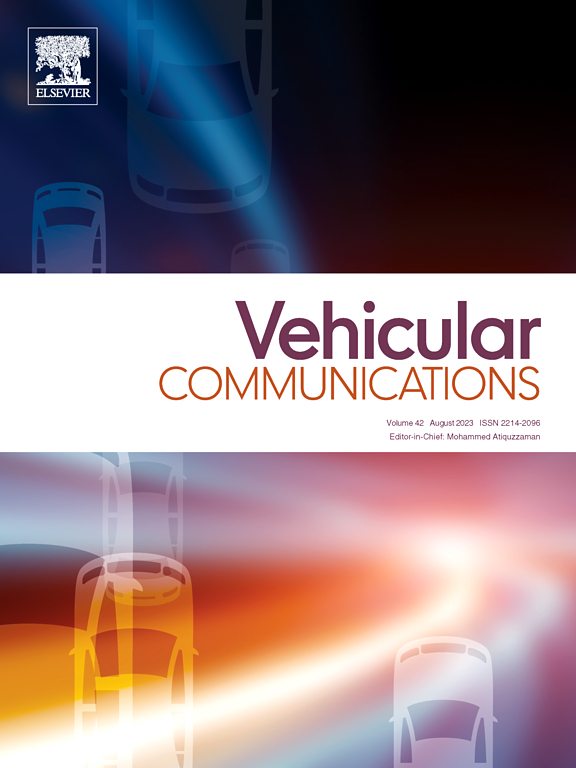一种基于车辆流量的车联网多路径管理算法
IF 6.5
2区 计算机科学
Q1 TELECOMMUNICATIONS
引用次数: 0
摘要
车联网(Internet of Vehicles, IoV)利用多种通信技术,将车辆、道路基础设施和云连接起来,实现车辆、车辆与基础设施、车辆与服务商之间的实时信息交换和智能交互,从而提高交通安全、交通效率和乘坐体验。一些学者提出在车联网中使用多路径传输控制协议(MPTCP)来提高其性能。然而,研究者在构建车联网传输算法时,忽略了用户偏好、业务特征、实际需求等影响因素。为了解决上述问题,本文提出了一种基于车辆交通的车联网路径管理算法,该算法包括两种算法:基于路径特征和信号特征的车联网路径管理算法(PCSC)和基于路径特征和交通服务的车联网路径管理算法(PCTS)。为了验证所提算法的性能,我们在mini - wifi软件中设计了一个车辆运动的仿真实验。结果表明,PCSC算法比传统的MPTCP算法和现有的路径传输算法具有更高的路径选择灵活性。PCTS算法的性能比PCSC算法更加精确,提高了网络的效率和吞吐量,解决了用户在不同时期的通信需求。本文章由计算机程序翻译,如有差异,请以英文原文为准。
A vehicular network multipath management algorithm based on vehicular traffic
Internet of Vehicles (IoV) uses a variety of communication technologies to connect vehicles, road infrastructure, and the cloud to achieve real-time information exchange and intelligent interaction between vehicles, vehicles and infrastructure, vehicles and service providers so as to improve traffic safety, traffic efficiency, and ride experience. Some scholars have proposed the use of Multipath Transmission Control Protocol (MPTCP) in IoV to improve its performance. However, researchers ignore the factors that influence it, such as user preferences, business characteristics, and actual needs, when constructing the transmission algorithm of IoV. In order to solve the above problems, this paper proposes a vehicular Network path management algorithm based on vehicular traffic, which includes two algorithms: the vehicular Network path management algorithm based on path characteristics and signal characteristics (PCSC) and the vehicular Network path management algorithm based on path characteristics and traffic service (PCTS). To verify the performance of the proposed algorithm, we designed a simulation experiment of vehicle movement in Mininet-WiFi software. The results show that the PCSC algorithm has higher path selection flexibility than the traditional MPTCP algorithm and the existing path transmission algorithms. The performance of the PCTS algorithm is more precise than the PCSC algorithm, which improves the efficiency and throughput of the network and solves the communication needs of users in different periods.
求助全文
通过发布文献求助,成功后即可免费获取论文全文。
去求助
来源期刊

Vehicular Communications
Engineering-Electrical and Electronic Engineering
CiteScore
12.70
自引率
10.40%
发文量
88
审稿时长
62 days
期刊介绍:
Vehicular communications is a growing area of communications between vehicles and including roadside communication infrastructure. Advances in wireless communications are making possible sharing of information through real time communications between vehicles and infrastructure. This has led to applications to increase safety of vehicles and communication between passengers and the Internet. Standardization efforts on vehicular communication are also underway to make vehicular transportation safer, greener and easier.
The aim of the journal is to publish high quality peer–reviewed papers in the area of vehicular communications. The scope encompasses all types of communications involving vehicles, including vehicle–to–vehicle and vehicle–to–infrastructure. The scope includes (but not limited to) the following topics related to vehicular communications:
Vehicle to vehicle and vehicle to infrastructure communications
Channel modelling, modulating and coding
Congestion Control and scalability issues
Protocol design, testing and verification
Routing in vehicular networks
Security issues and countermeasures
Deployment and field testing
Reducing energy consumption and enhancing safety of vehicles
Wireless in–car networks
Data collection and dissemination methods
Mobility and handover issues
Safety and driver assistance applications
UAV
Underwater communications
Autonomous cooperative driving
Social networks
Internet of vehicles
Standardization of protocols.
 求助内容:
求助内容: 应助结果提醒方式:
应助结果提醒方式:


